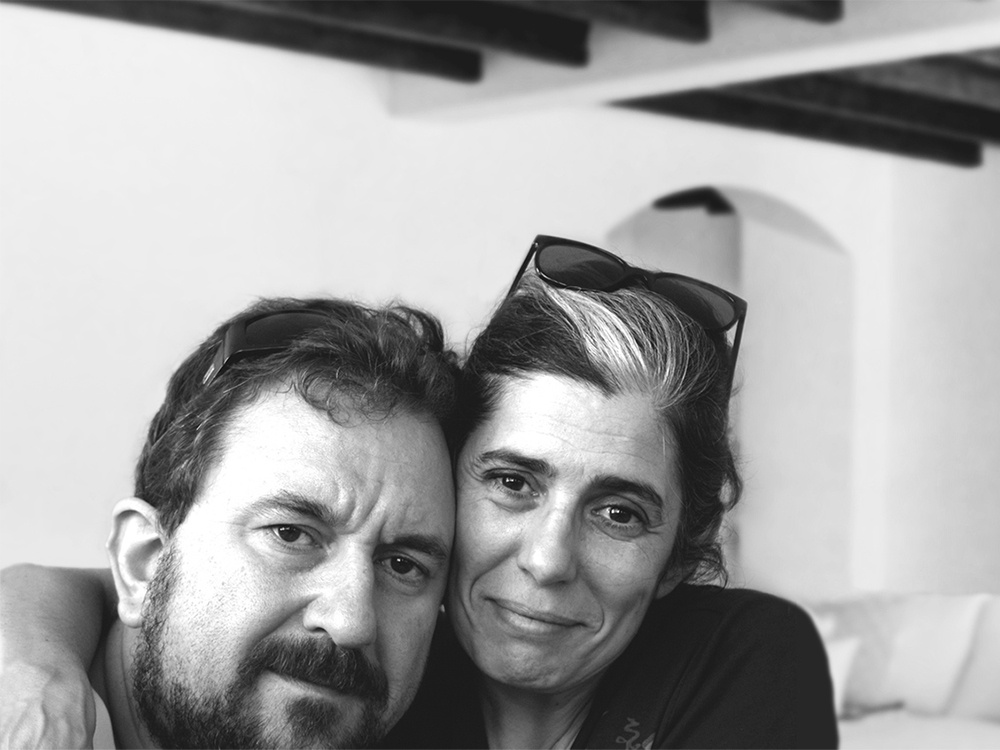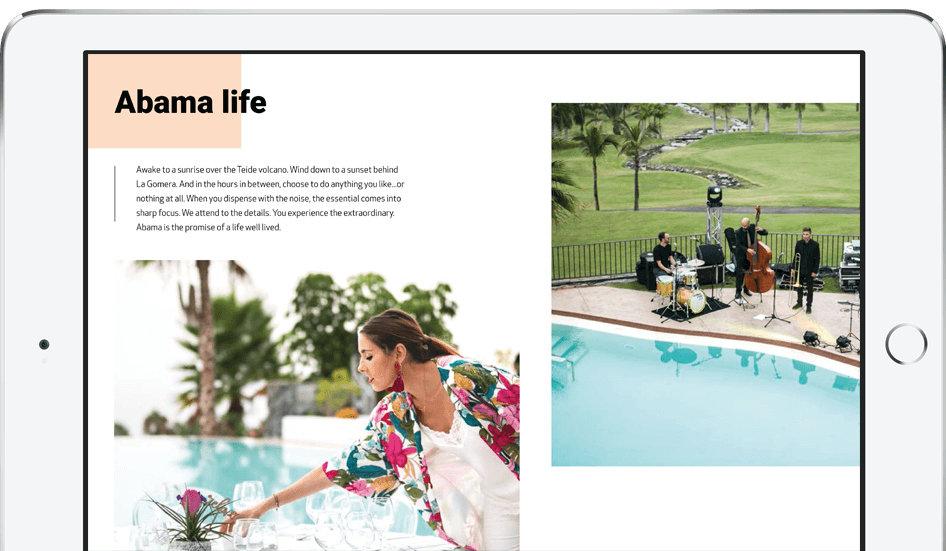
At Los Jardines de Abama in Tenerife, one lighting fixture has become indispensable: the Link Suspension lamp. This fixture has become an icon for Abama Luxury Residences for the promotion of its latest development of branded residences. Behind this design is the multi-award winning LZF, founded by Mariví Calvo and Sandro Tothill. LZF has gained recognition for its artisanal approach, focusing on the use of wood as a light diffuser, with nature as their main inspiration and incorporating techniques that influence well-being and the improvement of mental health.
LZF is unique in Spain for having received both major design awards: the National Craft Award in 2011 and the National Design Award in 2020. We spoke with the founders to learn more about their story and the inspiration behind the Link Suspension lamp and their other designs.
You come from very different fields: painting and music. What motivated you to enter the world of lighting together?
Our lives have been shaped by artistic creation in various cities and countries, whether through painting or performing music. This has made it easier for us to internalize different ways of understanding life.
Sandro moved from Australia to Ethiopia, where his father worked for the FAO. He later lived in Italy, then London, where he studied African Studies, combining it with musical creation, and eventually settled in Spain. I, on the other hand, studied History of Art and Fine Arts in Spain. A scholarship took me to New York to study collagraphy at the Pratt Institute in Brooklyn and I lived there for six years. I was also able to study graphic vision at the New York Holography Museum. I then lived in Madrid, Paris, and finally returned to my hometown, Valencia.
How did your paths cross?
We met during one of my visits to Valencia while living abroad, at a dinner organized by renowned Valencian sculptor Pepe Romero. Later, we temporarily set up in my studio, and a year later, a small accident changed our lives forever. While designing our new house, we happened to leave some thin sheets of wood on top of a large light table I had in the studio and just like that, we discovered the beauty of backlit veneer.
Our excitement led us first to create lighting fixtures for our home. After finishing, we decided to hold an exhibition called “Luzifer” (a play on a combination of words for light and make), which we organized in a Valencia theatre with the participation of over 30 artists who contributed their unique vision of creating a piece combining a light bulb with a wooden veneer cylinder. The success of the show, the positive reviews, and an order for 300 lamps for a hotel in Mallorca prompted us to found “Luzifer,” now LZF, which as I said, began in 1994 among friends, on the shores of the Mediterranean, that inexhaustible source of light, calm and joy.
How does your artistic and musical background influence LZF's designs and philosophy?
Musicians and painters often share a special sensitivity in how they deepen and present their work. For us, it means talking openly, giving our best, trying to transmit with an avant-garde language the keys of a world that you look at from your personal perspective, trying to make an impact, to go a little further, offering new approaches. This is why we constantly collaborate with other photographers and illustrators that we admire. Writers, musicians and artists also collaborate from time to time in the development of the campaigns as well as the product.

What innovations do you think LZF brings to the world of lighting and decoration?
LZF collections have their own identity, they are diverse and invite the customer to identify with them. Our main contribution, we believe, is in valuing the handmade, providing products that speak to the sensitivity and passion behind LZF's creations. We remain true to our philosophy, nature, respect for people, their well-being, and the importance of pursuing a dream
Working with an ancestral material such as wood, allows us to create a unique and memorable design language that draws the eye in a welcoming way, to travel a little further with our imagination, to dream of flying fish or seas of luminous wood.
You have mentioned the importance of biophilia and health in your designs. How is this reflected in your products?
We must recognize that over 99% of human history has been spent closely connected to nature, with only 1% reflecting modern day life.
It is the quality of our relationship and connection with nature that helps slow the decline in mental health. Given that we spend most of our time indoors under artificial lighting, our work begins with the study and behavior of wood, reinterpreted as a light diffuser, as a creator of positive and relaxing moods and bringing immediate therapeutic benefits. We are especially proud of our involvement with five hospitals in the U.S. dedicated to the cure of cancer, particularly with the work done for MSK in NY.

How do you think your lamps contribute to the well-being and happiness of the people who use them?
The other day I was reading an article that said Dr. Alison Pritchard, from the University of Derby (England), has found that people who feel more connected to nature have greater eudaimonic well-being, a type of satisfaction that goes beyond feeling good and includes having a meaningful purpose in life. It's something that touched me, because I personally like to identify with and give meaning to objects.
What does it mean to you that the “Link Suspension lamp” has become one of Abama's key marketing symbols and is prominently featured in its promotional materials and digital platforms?
In Abama every detail, in all its creative process, leads to contemplation, to a form of well-being connected to the ocean, where you feel the breeze and the smell of the sea, much like what happens in the Mediterranean.
The beautiful native natural materials used are perfectly aligned to offer peace and a universal pleasure that helps us to travel back in time, to a place that we had lost in memory and that suddenly becomes real, helping us to transform. The “Link” lamp is an object that embodies all these values, connecting with the Atlantic, with its sinuous curves in the form of gentle waves, and with the earth, through the wood.
What was the inspiration behind your design, and what artistic or cultural influences shaped its creation?
Our “Link” lamp is a Moebius wood strip that represents a paradox, a seemingly impossible figure that challenges our preconceived notions of reality. Its presence in culture and technology speaks of its innovative and creative power. The first application of this concept in LZF dates back to 1994, it was a “Moebius” applique designed by Mariví, based on a single wood veneer strip.
This has been a concept deeply ingrained in LZF's memory and its development was ideal for a mathematical designer like Ray Power, who in 2006 was in charge of continuing the evolution with a suspension lamp and, later, with a floor version, which relies on repetition and the union of multiple wood veneer strips.
In 2011 we were commissioned by Juli Capella to create a large-scale luminaire for Chef José Andrés' restaurant Mi casa in Puerto Rico. I led the project, adapting Ray’s vertical version to devise a new horizontal and endless composition

What techniques and materials did you use to shape the 'Link Pendant'?
At LZF we combine traditional knowledge, handmade by expert craftspeople, with technology and research. In the case of the 'Link' model, we selected bolivar wood, which is highly flexible and allows for extreme bending, while at the same time offering a cathedral-like pattern that significantly embellishes the design.
LZF has won over thirty-five national and international awards. Which recognition has been the most meaningful to you, and why?
We have been especially excited about the National Craftsmanship Award we received in 2011, and the National Design Award, which was granted to us in 2020. In fact, LZF is the only Spanish company to have received both awards.

How do you see the evolution of lighting and design in the coming years, and what role do you hope to play in that evolution?
We believe in a discourse that blends functionality with art design. We need nature in all its greatness to be introduced into our cities, our homes, our work spaces, in our lives. We need to evolve with it, we need to create objects with a balance that allow us to feel satisfaction, respect, protection and efficiency.







